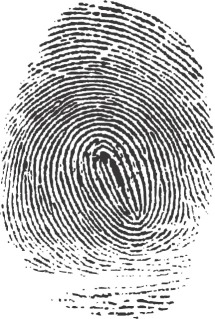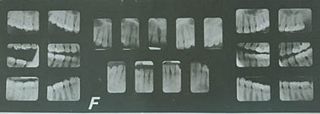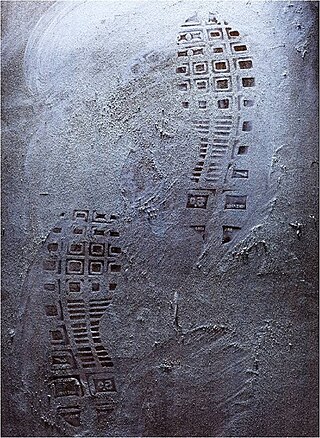
Forensic science, also known as criminalistics, is the application of science principles and methods to support legal decision-making in matters of criminal and civil law.

A fingerprint is an impression left by the friction ridges of a human finger. The recovery of partial fingerprints from a crime scene is an important method of forensic science. Moisture and grease on a finger result in fingerprints on surfaces such as glass or metal. Deliberate impressions of entire fingerprints can be obtained by ink or other substances transferred from the peaks of friction ridges on the skin to a smooth surface such as paper. Fingerprint records normally contain impressions from the pad on the last joint of fingers and thumbs, though fingerprint cards also typically record portions of lower joint areas of the fingers.

Forensic dentistry or forensic odontology involves the handling, examination, and evaluation of dental evidence in a criminal justice context. Forensic dentistry is used in both criminal and civil law. Forensic dentists assist investigative agencies in identifying human remains, particularly in cases when identifying information is otherwise scarce or nonexistent—for instance, identifying burn victims by consulting the victim's dental records. Forensic dentists may also be asked to assist in determining the age, race, occupation, previous dental history, and socioeconomic status of unidentified human beings.

A crime scene is any location that may be associated with a committed crime. Crime scenes contain physical evidence that is pertinent to a criminal investigation. This evidence is collected by crime scene investigators (CSI) and law enforcement. The location of a crime scene can be the place where the crime took place or can be any area that contains evidence from the crime itself. Scenes are not only limited to a location, but can be any person, place, or object associated with the criminal behaviours that occurred.
In forensic science, Locard's principle holds that the perpetrator of a crime will bring something into the crime scene and leave with something from it, and that both can be used as forensic evidence. Dr. Edmond Locard (1877–1966) was a pioneer in forensic science who became known as the Sherlock Holmes of Lyon, France. He formulated the basic principle of forensic science as: "Every contact leaves a trace". It is generally understood as "with contact between two items, there will be an exchange." Paul L. Kirk expressed the principle as follows:
Wherever he steps, whatever he touches, whatever he leaves, even unconsciously, will serve as a silent witness against him. Not only his fingerprints or his footprints, but his hair, the fibres from his clothes, the glass he breaks, the tool mark he leaves, the paint he scratches, the blood or semen he deposits or collects. All of these and more, bear mute witness against him. This is evidence that does not forget. It is not confused by the excitement of the moment. It is not absent because human witnesses are. It is factual evidence. Physical evidence cannot be wrong, it cannot perjure itself, it cannot be wholly absent. Only human failure to find it, study and understand it, can diminish its value.

Trace evidence occurs when objects make contact, and material is transferred. This type of evidence is usually not visible to the naked eye and requires specific tools and techniques to be located and obtained. Due to this, trace evidence is often overlooked, and investigators must be trained to detect it. When it comes to an investigation trace evidence can come in many different forms and is found in a wide variety of cases. This evidence can link a victim to suspects and a victim or suspect to the crime scene.
Forensic identification is the application of forensic science, or "forensics", and technology to identify specific objects from the trace evidence they leave, often at a crime scene or the scene of an accident. Forensic means "for the courts".
An electrostatic detection device, or EDD, is a specialized piece of equipment commonly used in questioned document examination to reveal indentations or impressions in paper that may otherwise go unnoticed. It is a non-destructive technique, allowing further tests to be carried out. It is a sensitive technique capable of detecting indentations on pages several layers below the top sheet and many years after the indentations were created.

Footprints are the impressions or images left behind by a person walking or running. Hoofprints and pawprints are those left by animals with hooves or paws rather than feet, while "shoeprints" is the specific term for prints made by shoes. They may either be indentations in the ground or something placed onto the surface that was stuck to the bottom of the foot. A "trackway" is a set of footprints in soft earth left by a life-form; animal tracks are the footprints, hoofprints, or pawprints of an animal.

A removable shoe insert, otherwise known as a foot orthosis, insole or inner sole, accomplishes many purposes, including daily wear comfort, height enhancement, plantar fasciitis treatment, arch support, foot and joint pain relief from arthritis, overuse, injuries, leg length discrepancy, and other causes such as orthopedic correction and athletic performance.

Forensic photography may refer to the visual documentation of different aspects that can be found at a crime scene. It may include the documentation of the crime scene, or physical evidence that is either found at a crime scene or already processed in a laboratory. Forensic photography differs from other variations of photography because crime scene photographers usually have a very specific purpose for capturing each image. As a result, the quality of forensic documentation may determine the result of an investigation; in the absence of good documentation, investigators may find it impossible to conclude what did or did not happen.
The following outline is provided as an overview of and topical guide to forensic science:

Forensic geology is the study of evidence relating to materials found in the Earth used to answer questions raised by the legal system.

A comparison microscope is a device used to analyze side-by-side specimens. It consists of two microscopes connected by an optical bridge, which results in a split view window enabling two separate objects to be viewed simultaneously. This avoids the observer having to rely on memory when comparing two objects under a conventional microscope.

Forensic tire tread evidence records and analyzes impressions of vehicle tire treads for use in legal proceedings to help prove the identities of persons at a crime scene. Every tire will show different amounts of tread wear, and different amounts of damage in the form of tiny cuts and nicks. These unique characteristics will also show on the impression left by the tire.

Forensic podiatry is a subdiscipline of forensic science in which specialized podiatric knowledge including foot and lower-limb anatomy, musculoskeletal function, deformities and diseases of the foot, ankle, lower extremities, and at times, the entire human body is used in the examination of foot-related evidence in the context of a criminal investigation. Forensic Podiatry has been defined as:
The application of sound and researched podiatry knowledge and experience in forensic investigations, to show the association of an individual with a scene of crime, or to answer any other legal question concerned with the foot or footwear that requires knowledge of the functioning foot.
The Integrated Automated Fingerprint Identification System (IAFIS) is a computerized system maintained by the Federal Bureau of Investigation (FBI) since 1999. It is a national automated fingerprint identification and criminal history system. IAFIS provides automated fingerprint search capabilities, latent searching capability, electronic image storage, and electronic exchange of fingerprints and responses. IAFIS houses the fingerprints and criminal histories of 70 million subjects in the criminal master file, 31 million civil prints and fingerprints from 73,000 known and suspected terrorists processed by the U.S. or by international law enforcement agencies.

Glove prints, also sometimes described as gloveprints or glove marks, are latent, fingerprint-like impressions that are transferred to a surface or object by an individual who is wearing gloves.

The murder of June Anne Devaney is a British child murder which occurred on 15 May 1948 when a girl aged 3 years 11 months was abducted from her cot while an inpatient at Queen's Park Hospital in Blackburn, Lancashire. The child was removed to the grounds of the hospital, where she was raped, before suffering extensive blunt force trauma to her skull when her head was repeatedly swung into a sandstone wall. The assault caused extensive internal injuries and multiple skull fractures, causing the child to develop a fatal state of shock. Her murderer, 22-year-old Peter Griffiths, was arrested three months after the crime and was subsequently tried and convicted of June Anne's murder. He was hanged on 19 November 1948.

Forensic firearm examination is the forensic process of examining the characteristics of firearms or bullets left behind at a crime scene. Specialists in this field try to link bullets to weapons and weapons to individuals. They can raise and record obliterated serial numbers in an attempt to find the registered owner of a weapon and look for fingerprints on a weapon and cartridges.




















